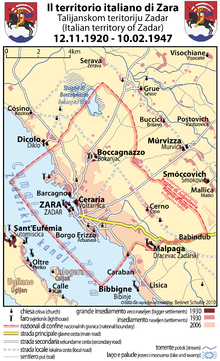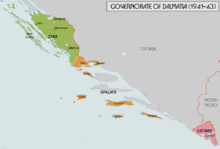
Dalmatia is one of the four historical regions of Croatia, alongside Central Croatia, Slavonia and Istria, located on the east shore of the Adriatic Sea in Croatia.

Zadar ; historically known as Zara, is the oldest continuously inhabited city in Croatia. It is situated on the Adriatic Sea, at the northwestern part of Ravni Kotari region. Zadar serves as the seat of Zadar County and of the wider northern Dalmatian region. The city proper covers 25 km2 (9.7 sq mi) with a population of 75,082 in 2011, making it the second-largest city of the region of Dalmatia and the fifth-largest city in the country.
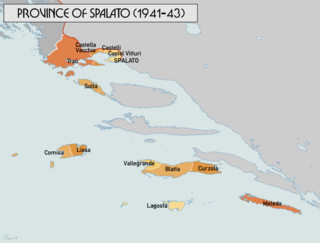
Province of Spalato was a province of the Italian Governorate of Dalmatia, created in May 1941 during World War II. It lasted until September 1943.

Italian irredentism was a political movement during the late 19th and early 20th centuries in Italy with irredentist goals which promoted the unification of geographic areas in which indigenous peoples were considered to be ethnic Italians. At the beginning, the movement promoted the annexation to Italy of territories where Italians formed the absolute majority of the population, but retained by the Austrian Empire after the Third Italian War of Independence in 1866. During World War I the main "irredent lands" were considered to be the provinces of Trento and Trieste and, in a narrow sense, irredentists referred to the Italian patriots living in these two areas.
The History of Dalmatia concerns the history of the area that covers eastern coast of the Adriatic Sea and its inland regions, from the 2nd century BC up to the present day.

The Istrian–Dalmatian exodus was the post-World War II exodus and departure of local ethnic Italians as well as ethnic Slovenes, Croats, and Istro-Romanians from Yugoslavia. The emigrants, who had lived in the now Yugoslav territories of the Julian March, Kvarner and Dalmatia, largely went to Italy, but some joined the Italian diaspora in the Americas, Australia and South Africa. These regions were ethnically mixed, with long-established historic Croatian, Italian, and Slovene communities. After World War I, the Kingdom of Italy annexed Istria, Kvarner, the Julian March and parts of Dalmatia including the city of Zadar. At the end of World War II, under the Allies' Treaty of Peace with Italy, the former Italian territories in Istria, Kvarner, the Julian March and Dalmatia were assigned to the nation of Yugoslavia, except for the Province of Trieste. The former territories absorbed into Yugoslavia are part of present-day Croatia and Slovenia.

The bombing of Zadar during the Second World War by the Allies lasted from November 1943 to October 1944. Although other large cities in Italy were also bombed, the bombing of Zadar stands out because of the number of attacks and the number of fatalities. Reports vary greatly; the Allies documented 30 bombing raids, while contemporary Italian accounts claim 54. Fatalities recorded range from under 1,000 to as many as 4,000 of the city's 20,000 inhabitants.
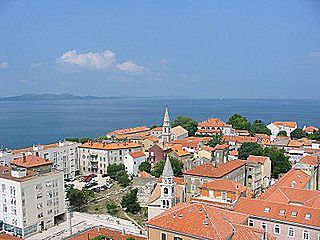
Dalmatian Italians are the historical Italian national minority living in the region of Dalmatia, now part of Croatia and Montenegro.

The Governorate of Dalmatia was a territory divided into three provinces of Italy during the Italian Kingdom and Italian Empire epoch. It was created later as an entity in April 1941 at the start of World War II in Yugoslavia, by uniting the existing Province of Zara together with occupied Yugoslav territory annexed by Italy after the invasion of Yugoslavia by the Axis powers and the signing of the Rome Treaties.
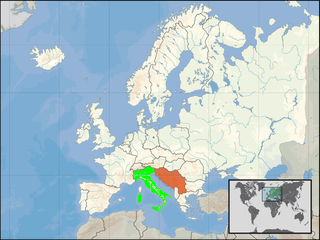
Italy–Yugoslavia relations are the cultural and political relations between Italy and Yugoslavia in the 20th century, since the creation of Yugoslavia in 1918 until its dissolution in 1992. Relations during the interwar years were hostile because of Italian irredentist demands to Yugoslav territory, leading to Fascist Italy and the Axis Powers invading Yugoslavia during World War II. After lingering tensions after the war over the status of the Free Territory of Trieste, relations improved during the Cold War.

Angelo Antonio Frari was a Dalmatian Italian physician, who served as the municipal physician and the head of the lazaretto of Split, province of Spalato (1806–1821), the protomedicus, and the president of the Maritime Health Magistrate of Venice (1835–1843), famous epidemiologist and historian of medicine.
The Autonomist Party was an Italian-Dalmatianist political party in the Dalmatian political scene, that existed for around 70 years of the 19th century and until World War I. Its goal was to maintain the autonomy of the Kingdom of Dalmatia within the Austro-Hungarian Empire, as opposed to the unification with the Kingdom of Croatia-Slavonia. The Autonomist Party has been accused of secretly having been a pro-Italian movement due to their defense of the rights of ethnic Italians in Dalmatia. The Autonomist Party did not claim to be an Italian movement, and indicated that it sympathized with a sense of heterogeneity amongst Dalmatians in opposition to ethnic nationalism. In the 1861 elections, the Autonomists won twenty-seven seats in Dalmatia, while Dalmatia's Croatian nationalist movement, the National Party, won only fourteen seats. This number rapidly decreased: already in 1870 autonomists lost their majority in the Diet, while in 1908 they won just 6 out of 43 seats.

In 1918–1920, a series of violent fights took place in the city of Split between Croats and Italians, culminating in a struggle on 11 July 1920 that resulted in the deaths of Captain Tommaso Gulli of the Italian protected cruiser Puglia, Croat civilian Matej Miš, and Italian sailor Aldo Rossi. The incidents were the cause of the destruction in Trieste of the Slovenian Cultural Centre by Italian Fascists.

Italians of Croatia are an autochthonous historical national minority recognized by the Constitution of Croatia. As such, they elect a special representative to the Croatian Parliament. There is Italian Union of Croatia and Slovenia, in Croat Talijanska Unija, in Slovene Italijanska Unija, which is Croat-Slovene organization with main site in Fiume-Rijeka and secondary site in Capodistria-Koper of Slovenia.

Italian irredentism in Dalmatia was the political movement supporting the unification to Italy, during the 19th and 20th centuries, of Adriatic Dalmatia.
The 1941 Treaties of Rome were a series of treaties concluded by the Fascist Italian regime and the World War II collaborationist Independent State of Croatia on 18 May 1941, following the Axis Invasion of Yugoslavia. The treaties determined the borders between the NDH and Italy, effectively ceding territory largely organised as the Governorate of Dalmatia to the latter. They also prohibited the NDH from deploying naval forces to the Adriatic Sea, and restricted movement of its troops in the Italian-controlled part of the NDH.
Stevo Rađenović was a Yugoslav Radical Union politician during the interwar period and a Chetnik leader in the Lika region of the Axis puppet state, the Independent State of Croatia during World War II. He was a prominent leader of the July 1941 Srb uprising against the genocidal Ustaše-led NDH government, and was the first Chetnik leader in the region to reach an understanding with the Royal Italian Army in order to collaborate with them against the Yugoslav Partisans.

Giacomo Vuxani was an Italian politician and patriot born in the Arbanasi village of Borgo Erizzo, a suburb of Zadar.

Vincenzo Serrentino was an Italian Fascist politician and civil servant, prefect of the Province of Zara from November 1943 to October 1944.
NK Arbanasi is a football club from the village of Arbanasia near Zadar. Founded in 1910 as NK Zmaj, it is one of the oldest football clubs in Croatia in continuous existence.



